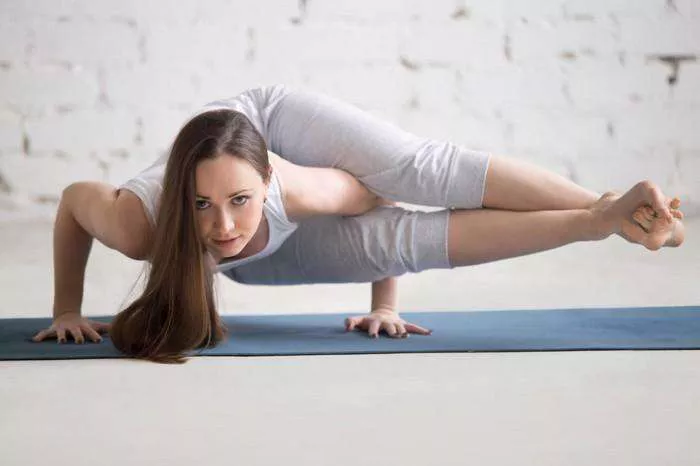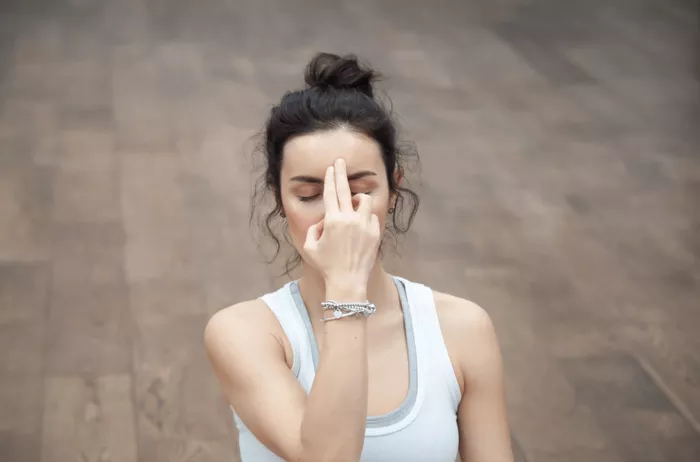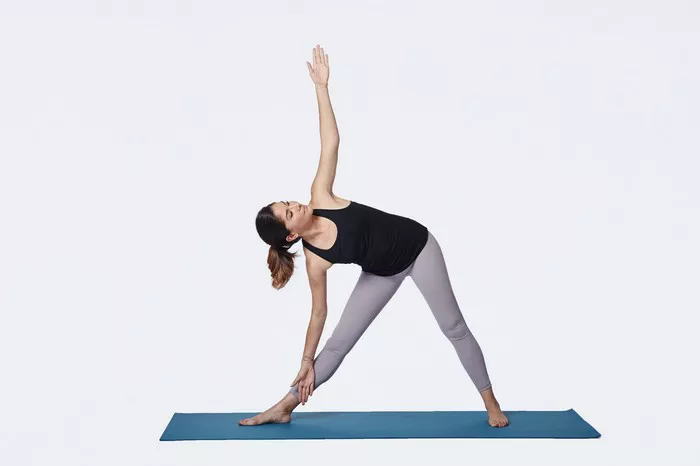Yoga, an ancient practice originating in India, has evolved into a worldwide phenomenon known for its physical, mental, and spiritual benefits. Among its diverse range of poses, some require advanced levels of flexibility, strength, and balance. These poses, often termed “advanced,” challenge even seasoned practitioners to deepen their practice. In this article, we delve into 15 advanced yoga poses, exploring their intricacies, benefits, and the precautions necessary for their safe practice.
1. Eka Pada Rajakapotasana (One-Legged King Pigeon Pose):
Eka Pada Rajakapotasana is an intense hip opener that requires both flexibility and strength. To perform this pose, begin in a low lunge position with one knee forward and the other extended behind. Slowly bring the front foot towards the opposite hand, aiming to place the shin parallel to the front of the mat. Then, extend the back leg straight behind, keeping the hips square. This pose deeply stretches the hip flexors, quadriceps, and groin while also stimulating the abdominal organs.
2. Vrischikasana (Scorpion Pose):
Vrischikasana, or Scorpion Pose, is an advanced inversion that demands significant core strength, flexibility, and balance. From a forearm stand position, slowly bend the knees and arch the back, aiming to bring the feet towards the head. The final expression of the pose involves balancing on the forearms with the feet pointing towards the head. Scorpion Pose strengthens the shoulders, arms, and core muscles while improving focus and concentration.
3. Astavakrasana (Eight-Angle Pose):
Astavakrasana is a challenging arm balance that requires both strength and flexibility. Begin seated with one leg crossed over the other, then hook one arm around the bent knee and the other arm behind the back. Lean forward, engaging the core, and shift the weight onto the hands, lifting the hips off the ground. Extend the legs out to the side, creating an “eight” shape with the body. This pose strengthens the arms, wrists, and core while improving balance and focus.
4. Kasyapasana (Kasyapa’s Pose):
Kasyapasana is an advanced twist that offers a deep stretch for the spine and shoulders. Begin seated with the legs extended in front. Bend the right knee and place the foot on the outside of the left thigh. Wrap the left arm around the right knee, twisting the torso towards the right. Extend the right arm behind the back, reaching for the opposite hip or binding the hands together. Kasyapasana detoxifies the organs, improves spinal mobility, and enhances digestion.
5. Mayurasana (Peacock Pose):
Mayurasana, or Peacock Pose, is a challenging arm balance that strengthens the wrists, arms, and core muscles. Begin in a kneeling position with the hands shoulder-width apart and fingers pointing towards the body. Lean forward, placing the elbows into the abdomen and lifting the legs off the ground, balancing on the hands. Straighten the legs, engaging the core, and extend them parallel to the ground. Peacock Pose improves digestion, stimulates the abdominal organs, and enhances overall strength and stability.
6. Koundinyasana (Sage Koundinya’s Pose):
Koundinyasana is an advanced arm balance that requires both strength and flexibility. Start in a low lunge position with the hands planted on the ground shoulder-width apart. Shift the weight onto the hands and bend the elbows, bringing the torso forward. Extend one leg out to the side, hooking it over the upper arm while keeping the other leg bent. With practice, lift the back leg off the ground, balancing the body on the hands. This pose strengthens the arms, wrists, and core while improving balance and concentration.
7. Visvamitrasana (Sage Visvamitra’s Pose):
Visvamitrasana is a complex side arm balance that challenges both strength and flexibility. Begin in a wide-legged stance with the right foot turned out and the left foot turned slightly in. Bend the right knee and place the hand on the inside of the foot, reaching the left arm overhead. With practice, extend the right leg straight, engaging the core and balancing the body on the right arm. Visvamitrasana strengthens the arms, shoulders, and core muscles while improving focus and concentration.
8. Parsva Bakasana (Side Crow Pose):
Parsva Bakasana, or Side Crow Pose, is an advanced arm balance that requires core strength and balance. Begin in a squat position with the knees bent and the hands planted shoulder-width apart on the ground. Shift the weight onto the hands and lean forward, placing the knees on the outside of the upper arms. With practice, lift the feet off the ground, balancing the body on the hands. Side Crow Pose strengthens the arms, wrists, and core while improving balance and focus.
9. Hanumanasana (Monkey Pose):
Hanumanasana is an advanced seated pose that offers a deep stretch for the hamstrings, groin, and hip flexors. Begin in a low lunge position with one knee forward and the other extended behind. Slowly straighten the front leg, sliding the back foot back until both legs are straight and the hips are square. With practice, lower the torso towards the front leg, folding forward at the hips. Hanumanasana improves flexibility in the legs and hips while promoting relaxation and calm.
10. Vasisthasana (Side Plank Pose):
Vasisthasana is an advanced variation of the traditional plank pose that strengthens the arms, wrists, and core muscles. Begin in a plank position with the hands directly under the shoulders and the body in a straight line from head to heels. Shift the weight onto the right hand and outer edge of the right foot, stacking the left foot on top. Extend the left arm towards the ceiling, creating a straight line from fingertips to toes. Side Plank Pose improves balance, strengthens the arms and core, and tones the waist.
11. Urdhva Dhanurasana (Upward Bow or Wheel Pose):
Urdhva Dhanurasana is an advanced backbend that offers a deep stretch for the chest, shoulders, and spine. Begin lying on the back with the knees bent and the feet hip-width apart. Place the hands by the ears, fingers pointing towards the shoulders. Press into the hands and feet, lifting the hips towards the ceiling and straightening the arms. With practice, straighten the arms completely, lifting the chest and head off the ground. Upward Bow Pose strengthens the arms, shoulders, and legs while improving spinal flexibility and posture.
12. Eka Hasta Bhujasana (Elephant’s Trunk Pose):
Eka Hasta Bhujasana is an advanced arm balance that challenges both strength and balance. Begin in a squat position with the knees bent and the hands planted on the ground shoulder-width apart. Shift the weight onto the hands and lean forward, placing one knee on the back of the corresponding upper arm. With practice, lift the opposite foot off the ground, extending the leg straight out to the side. Elephant’s Trunk Pose strengthens the arms, wrists, and core while improving balance and focus.
13. Dwi Pada Viparita Dandasana (Two-Legged Inverted Staff Pose):
Dwi Pada Viparita Dandasana is an advanced backbend that offers a deep stretch for the chest, shoulders, and spine. Begin seated with the hands placed several inches behind the hips, fingers pointing towards the feet. Bend the knees and place the feet on the ground hip-width apart. Press into the hands and feet, lifting the hips towards the ceiling and straightening the arms. With practice, extend the legs straight, lifting the hips higher and opening the chest towards the ceiling. Two-Legged Inverted Staff Pose strengthens the arms, shoulders, and legs while improving spinal flexibility and posture.
14. Kapotasana (King Pigeon Pose):
Kapotasana is an advanced backbend that offers a deep stretch for the chest, shoulders, and hip flexors. Begin kneeling with the knees hip-width apart and the hands placed on the lower back for support. Slowly walk the hands down the back of the thighs, reaching for the ankles or feet. With practice, lean back, opening the chest towards the ceiling and lifting the heart towards the sky. King Pigeon Pose strengthens the back muscles, improves posture, and promotes emotional release.
15. Salamba Sirsasana (Supported Headstand):
Salamba Sirsasana is an advanced inversion that offers numerous benefits for physical and mental well-being. Begin kneeling with the forearms on the ground and the hands interlaced, forming a triangle with the elbows. Place the crown of the head on the ground, creating a stable base, and lift the hips towards the ceiling. Walk the feet towards the body, straightening the legs and engaging the core. With practice, lift the legs towards the sky, finding balance in the pose. Supported Headstand strengthens the arms, shoulders, and core while improving focus, balance, and circulation.
Conclusion
In conclusion, advanced yoga poses offer practitioners an opportunity to deepen their practice and explore new levels of strength, flexibility, and balance. However, it is essential to approach these poses mindfully, respecting the body’s limitations, and seeking guidance from experienced teachers. With dedication and perseverance, advanced yoga poses can not only enhance physical fitness but also cultivate a sense of inner peace and well-being.























